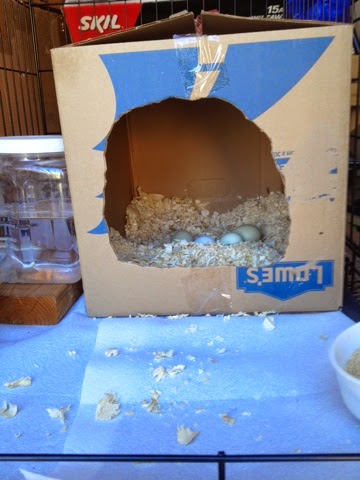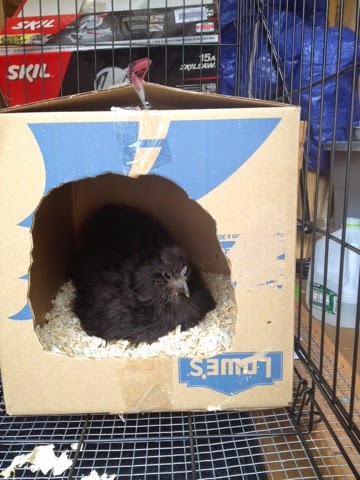Preparation
- The hardware on the prebuilt coop was not adequate. While the nesting box had a lock, the doors didn't. To prevent raccoons and other predators from gaining access, I added those, along with latches to keep the roof and droppings tray from being opened. I like to use the catches from the leashes I bought from the dollar store. They are cheap and easy to use.
- More ventilation was needed. It had one little screened window. I used a drill and key hole saw to cut a hole in the other side of the coop and covered it with hardware cloth to provide more ventilation.
- Updating the roosts. The roosts were lower than the egg boxes. Moved one of the roosts up 12".
- Restaining. I performed the water bead test on the coop. Put a drop of water on the coop. If it soaks in, it isn't waterproof. I bought some stain from a local hardware store and repainted it.
- Adding additional run space. The hens and chicks looked a little crowded, so I added some additional space by building an extension under the external egg box. This gave them an extra 2 square feet of space.
Access
The coop I bought had four access points: a door to the run, a door to the coop, the lid to the external nesting box, and the roof that opened. The roof that opened was not as useful as I had thought. It was hard to reach the bottom of the coop. There was only a single door to access the run. This meant if a chicken went under the coop, there wasn't any good way to reach it. I took out one of the hardware cloth panels under the coop and added another door.
Another thing I realized is to reach into the run required me to kneel down. This meant I often ended up with little chicken presents on my pants since they like to hang out near the coop when free ranging. This also meant while cleaning I was on my hands and knees. I finally bought a pair of knee pads for gardening to help with this problem.
The small doors also made it difficult to access the run when wearing a heavy coat in fall and winter. The coat kept getting me caught in the door way.
Dealing with food and water.
Those pictures of happy chickens in these coops rarely show food or water. I made a feeder out of 3" pvc pipe parts. I didn't need to glue the pieces together, I just used duck tape. I put it in the coop to keep it dry and used a wire and some eye screws to keep it from getting knocked over.
For water, I added chick nipple waterer I had purchased at the farm supply store.
Summer turned to fall. The temperatures started dropping below freezing. The water started freezing. Because I was going to need someone else to watch my chickens sometimes, the "carry out hot water" approach wasn't going to work.
I tried two different solutions. I tried a heated dog dish. The water didn't freeze, however, when I tried to get the bowl in or out of the coop, I often spilled it, which meant tons of wet bedding. The second solution was a three gallon horizontal nipple waterer with a stock tank heater in it. I was able to get it in and out without spilling, but it took up more room.
Cleaning
I did not find the slide out tray to be very useful. The metal it was coated with made it very slippery for the chickens to walk on, so I added in pine shavings. When I tried to get the tray out, the bedding tended to fall out into the run. I discovered I had a small dust pan that fit right through the door, so I just used that to scoop out bedding when it needed to be changed.
The pop door
The pop door was a horizontal sliding one. Bedding liked to get caught in the track and prevent it from closing. I was often down on my knees picking pine shavings out of the track so the door could close completely. My plan was to put a paint stick across the doorway inside the coop to keep the bedding in. I haven't gotten around to it. This pop door also doesn't lock. I decided since the run was locked, that was good enough. I think something could be put through the push handle to lock it.
Weather
Something I quickly learned was the run was not as weather proof as I had hoped. Because the run is only a little over two feet wide, rain and snow can blow the entire way across it. In a light rain, it's ok and things stay reasonably dry, but add in a few gusts of wind and all the pine shavings in the run are soaked. I found this out the hard way, culminating in me having to blow dry three shivering, snowy silkies.
Small coop as a brooder
I had two different bantams hatching eggs. I put one in the nesting box and the other in a cardboard box in the run under the coop. Having a broody in that nesting box was ideal. I had easy access to her and later, her chicks.
The final transformation
With winter on us, I finally decided this small coop wasn't good for the snowy winters we get where I live. It was great for a bantam hen and her chicks. It was great as a grow out pen. It did not work well as a permanent home. I sold half my bantams and moved the rest into my other coop, until next year when I use this coop to hatch more chicks.






